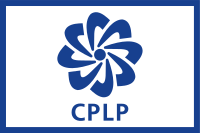
Back Gemeenskap van Portugese Lande Afrikaans CPLP ALS مجموعة البلدان الناطقة بالبرتغالية Arabic Comunidá de Países de Llingua Portuguesa AST Португал телле илдәр берләшмәһе Bashkir Gmeinschaft vo de Portugiesischsprechadn Lända BAR Садружнасць партугаламоўных краін Byelorussian Общност на португалоезичните държави Bulgarian Zajednica država portugalskog govornog područja BS Comunitat de Països de Llengua Portuguesa Catalan
Comunidade dos Países de Língua Portuguesa Community of Portuguese Language Countries | |
|---|---|
 Map of CPLP member states (blue) and associate observers (green) | |
| Headquarters | Penafiel Palace Lisbon, Portugal 38°42.65′N 9°8.05′W / 38.71083°N 9.13417°W |
| Official language | Portuguese |
| Membership |
|
| Leaders | |
• Director-General | |
• President of the Parliamentary Assembly | |
| Establishment | 17 July 1996 |
| Area | |
• Total | 10,743,526 km2 (4,148,099 sq mi) |
| Population | |
• Estimate | 287 million (2021) |
Website cplp.org | |
The Community of Portuguese Language Countries (Portuguese: Comunidade dos Países de Língua Portuguesa; abbr. : CPLP), also known as the Lusophone Community (Portuguese: Comunidade Lusófona),[1][2] is an international organization and political association of Lusophone nations across five continents, where Portuguese is an official language. The CPLP operates as a privileged, multilateral forum for the mutual cooperation of the governments, economies, non-governmental organizations, and peoples of the Lusofonia.[3] The CPLP consists of 9 member states and 33 associate observers, located in Europe, South America, Asia, Africa and Oceania, totaling 38 countries and 4 organizations.
The CPLP was founded in 1996, in Lisbon, by Angola, Brazil, Cape Verde, Guinea-Bissau, Mozambique, Portugal, and São Tomé and Príncipe, nearly two decades after the beginning of the decolonization of the Portuguese Empire. Following the independence of East Timor in 2002 and the application by Equatorial Guinea in 2014, both of those countries became members of the CPLP. Macau (a Special Administrative Region of China), Galicia (an Autonomous Community of Spain), and Uruguay are formally interested in full membership and another 17 countries across the world are formally interested in associate observer status.
- ^ Rogers-Glabush, Julie (4 October 2009). IBFD International Tax Glossary. IBFD. ISBN 9789087220570 – via Google Books.
- ^ Africa South of the Sahara 2003. Psychology Press. 31 October 2002. ISBN 9781857431315 – via Google Books.
- ^ "CPLP Objectivos" (in Portuguese). CPLP. Retrieved 23 July 2014.
